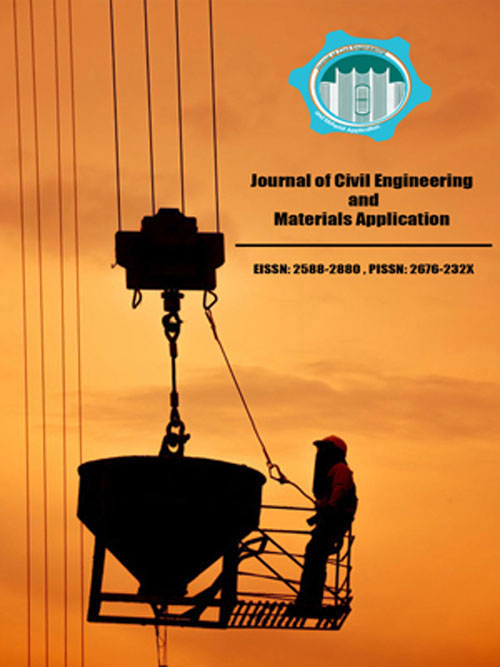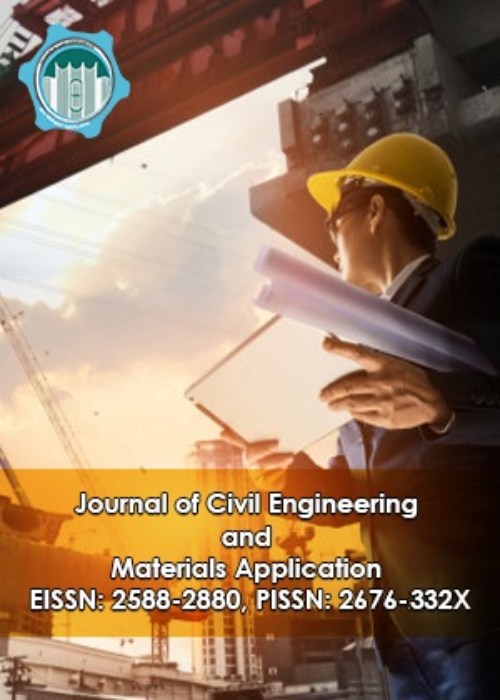فهرست مطالب

Journal of Civil Engineering and Materials Application
Volume:5 Issue: 4, Autumn 2021
- تاریخ انتشار: 1400/11/02
- تعداد عناوین: 5
-
Pages 164-176
Today, monitoring groundwater quality and the trend of its changes for drinking, industrial and agricultural uses is very important for the general health of society. Due to changes in groundwater quality that can be due to climatic or human factors, it is necessary to consider and study these resources to maintain their quality. The purpose of this study is to investigate the quality and effective factors in groundwater quality changes in Khorramabad from 2005 to 2018 using the global water quality index (WQI) and coherence and cross wavelet. To achieve this goal, first, the drought assessment of Khorramabad city has been studied according to precipitation data using index (SPI). Then, using the world water quality index (WQI), the groundwater quality of Khorramabad has been studied. The results showed that the quality of groundwater in Khorramabad during the years 2005 to 2018 was in standard condition. Also, the correlation between the chemical parameters of groundwater has been evaluated. The results of coherence and cross wavelet showed that the relative effect of precipitation with a wavelet coherence coefficient of 0.5 has been more compared to other factors in changes groundwater quality Khorramabad city. Therefore, it can be said that the relative impact of climatic factors on changes in groundwater quality in Khorramabad has been more than the other factors. Accordingly, appropriate management strategies for groundwater quality resources and mitigation solutions are imperatively needed to ensure the sustainability of the groundwater resource and the protection of public health in the Khorramabad city.
Keywords: SPI, Water Quality, Khorramabad, WQI, Coherence Wavelet -
Pages 177-195
In recent years, geopolymers, as a new class of green cement binders, have been considered as an environmental-friendly alternative to Ordinary Portland Cement (OPC) which can potentially reduce negative environmental impacts of OPC. Geopolymers are inorganic alumina-silicate materials produced from raw materials in combination with an alkaline activator solution. The alkaline activator solution as one of pillar of the geopolymerization process, playing an important role in the formation of crystalline structures of Si and Al. Therefore, it seems necessary to study the impact of various alkaline activator solutions on the mechanical strength of Geopolymer Concrete (GPC). On the other hand, in most pervious research in this regard, GPC based on Class F fly ash and high temperature curing condition have been studied. Hence, in this research, Class C fly ash and ambient curing condition were used to make GPC. The obtained results indicated that in ambient curing condition, using sodium hydroxide and sodium silicate, results in higher compressive strength as well as, lower permeability compared to potassium-based (potassium hydroxide and potassium silicate) and combination of sodium and potassium-based alkaline activator solutions. But, at elevated curing temperatures, potassium-based activator provided higher compressive strength. Moreover, simultaneous inclusion of NaOH and KOH led to decline the compressive strength. Furthermore, the obtained results indicated that increasing the NaOH and KOH concentration resulted in higher compressive strength. The optimal SiO2/Na2O ratio was 2 in the case of using 14M NaOH solution and 2.5 in the case of using 10M NaOH solution.
Keywords: Geopolymer concrete, Fly ash, Alkaline activator solution, Compressive strength, Resistance to acidic condition -
Pages 197-210
Composite columns are columns consisting of a base section and one or more reinforcement sections (filler or filler). The components of a composite are not chemically combined so that the components fully retain their chemical and natural nature and there is a certain common level between the components. In terms of reinforcement, composites are divided into two categories: fiber-reinforced composites (FRC) and particle-reinforced composites (PRC). FRP composite profiles are composite materials that are obtained from carbon fibers, glass or aramid embedded in a polymer resin (epoxy resin or polyester resin) and as a suitable alternative for places where the use of steel profiles due to the presence of Severe corrosion or the presence of strong magnetic fields is not possible. Common composite columns, as a combination of concrete and composite steels, include FRP rebars and other types of composite rebars. In this research, the study of structural columns made of fiber reinforced concrete (FRP) surrounded by fiber reinforced polymers (FRC) is presented. Modeling will be performed using Abaqcus finite element software. After numerical analysis, it was found that fiber concrete has a better and better functional behavior than the column with ordinary concrete and also the effect of reinforced fibers increases the compressive strength of the column.
Keywords: Composite rebars, Fiber Reinforced Polymers, structural columns -
Pages 211-221
Based on various sources and experiences, the main phases of clinker have a significant impact on the technical characteristics of cement and its performance in the resulting concrete. The interaction of clinker phases with concrete admixtures is also obvious, but the effect of each of these phases and their optimal values for optimal concrete performance is complicate. Therefore, in this study, this issue was an extensive laboratory operation was designed. In the first phase, during three months, weekly sampling of two-kiln clinker of the cement factory was performed. Then, through 25 clinker samples taken, 11 samples were selected whose phase values were varied. During the second phase, laboratory cementation was performed under the same conditions using 11 clinker samples. A sample of high-consumption super plasticizer additive was also prepared. In the third phase, physical and chemical analysis of cement samples was performed. During the fourth phase, 22 concrete mixtures with 11 cement samples were prepared, so that 11 mixtures with the title of control (without additives) and 11 mixtures with the title of additives. Slump loss tests, air content, compressive strength of hardened concrete of 7, 28 and 90 days were performed on concrete mixtures and optical characteristics of fresh concrete mixtures were recorded for comparison. Based on the results, comparing the effect of C3S clinker on the compressive strength of standard mortar and concrete showed that there is no direct correlation between C3S and compressive strength (mortar and concrete), but it can be said that with each percentage increase of C3S clinker, about 1.5 unit (kg/cm2), 7 and 28 days strength of concrete increases. However, with the increase of C3S from about 57% onwards, the decrease in concrete strength is clearly seen, which can be referred to the negative effect of excessive C3S phase (due to the solubility of concrete and increasing the w/c ratio). Based on the results of air determination experiments of fresh concrete mixtures containing additives and its declining trend in this study, it was found that the optimal value of C3A is about 5-6%.
Keywords: Alite, Aluminate, Additive -
Pages 223-232
Fiber-containing concretes are among the new generations of concrete that have been considered by researchers and engineers for decades. Fibers play a very important role in improving the weaknesses of concrete, including the tensile and flexural strengths of concrete. In re cent years, researchers have done a lot of research on the properties of fiber concrete and concretes with different fibers such as: steel, carbon, polypropylene, glass, as well as plant fibers such as: palm, hemp, coconut and/or even examined fibers from recycled materials such as car tyre and sacks. In order to study the effect of length and percentage of steel fibers on tensile and compressive strengths of concrete, in this study, it is intended to create three concrete models with conventional concrete mixing design and by adding steel fibers with a length of 3 and 5 cm and Also, their combination should be tested with volume percentages of 0.5%, 1% and 1.5%. In addition, samples of plain concrete were made to determine the effect of fibers on the strength of concrete. Then, using the hydrulic jack machine, tension and compression strength tests were performed on the concrete specimens. Based on the obtained results, it seems that with increasing the length and percentage of steel fibers, the tensile and compressive strengths of concrete increase. Also, based on the observations made, it can be interpreted that samples containing a combination of 3 and 5 cm steel fibers in concrete have lower strength than 5 cm samples and more resistance than 3 cm samples, respectively. Reports. Based on the experiments performed and taking into account the comparisons made, the use of 5 cm steel fibers is recommended to increase the tensile and compressive strengths of concrete with different percentages compared to 3 cm steel fibers.
Keywords: Fiber reinforced concrete, Steel Fiber, hybrid fiber, Tension strength, Compression strength


